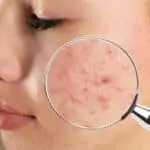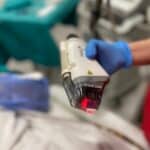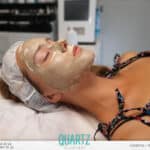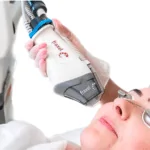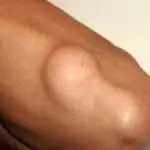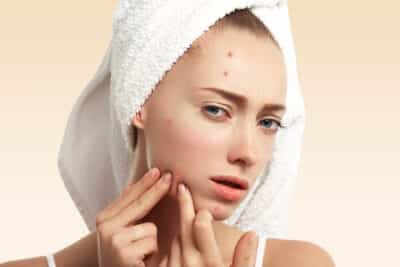 Acne, popularly known as acne, is a common skin disease in both men and women. Acne, which begins to appear especially in adolescence, is seen in 85% of young people. However, acne is not just a skin problem that occurs in adolescence. Adult-type acne seen at a late age is also common. Adult acne is a skin disease that occurs more often in women. The most important difference from acne that occurs in adolescence is that they are more resistant to acne treatment.
Acne, popularly known as acne, is a common skin disease in both men and women. Acne, which begins to appear especially in adolescence, is seen in 85% of young people. However, acne is not just a skin problem that occurs in adolescence. Adult-type acne seen at a late age is also common. Adult acne is a skin disease that occurs more often in women. The most important difference from acne that occurs in adolescence is that they are more resistant to acne treatment.
The first occurrence of acne is generally between the ages of 10-17 in adolescent girls and 14-19 years in adolescent boys. Men have more acne than women. It does not have any side effects that affect health. However, acne that starts in adolescence and does not go away afterward causes some psychological problems. Acne that is not treated at the right time and is frequently touched turns into serious permanent scars called scars. Acne is most common in autumn and winter. However, there are acnes that increase in direct proportion with oil secretion due to sweating in summer.
Although acne can be seen in different parts of the body, it is usually concentrated in the face area. Apart from the face, acne formation is observed mainly on the back, neck, chest, shoulders and upper arms. This is due to the excess of sebaceous glands in these areas. Normally, the oil secreted by these glands is excreted on the skin surface. However, in adolescence, the sebaceous glands secrete more oil than necessary, and the channels that allow this oil to pass to the skin surface are blocked. This accelerates the formation of acne.
What is acne?
Acne is an inflammation that appears in some parts of the body as a result of the sebaceous glands and hair follicles forming on the skin not working properly, and is observed at all ages, mostly in adolescents. The sebaceous gland, called the pilosebaceous unit, consists of the hair follicle and the common channel, and this channel ends on the skin surface. The sebaceous glands produce oil secretion known as sebum and this secretion opens towards the skin surface through the duct.
Bacteria multiply in this plug and inflammation occurs. This inflammation gives symptoms such as swelling, redness, temperature increase and pain.
The result is tiny inflammatory blisters known as acne.
How does acne occur?
There are many factors that cause acne formation. The causes of acne seen in adolescence and acne seen in later ages may differ. But in general, the main factors affecting acne formation are as follows:
- Structural features
- Hormonal imbalances
- Intense stress
- Increased sebum production
- Changes in the follicle
- bacteria
- Extremely oily skin surface
- Miss use of cosmetic products and some drugs used.
- Genetic predisposition is one of the most important factors affecting acne formation. It is beneficial for people with a family history of severe acne to benefit from early diagnosis and treatment. Apart from genetic factors, acne also occurs due to intense stressful life, misuse or excessive use of cosmetic products, and some hormonal irregularities. Apart from these, increased oil secretion is one of the other important factors. People with acne on their body have larger sebaceous glands and have more oil production in their bodies than people with other normal skin types. Hormones also play an important role in acne formation. Before puberty, skin pores are smaller.
The cells that produce sebum and keratin cannot form a plug and move in the canal and discharge onto the skin surface.
For this reason, the production of sebaceous glands is less and this is insufficient for acne formation. However, when it comes to puberty, the sebaceous glands enlarge with the effect of hormones. As a result, oil production increases and acne occurs.
Improper or excessive use of cosmetic products also triggers acne formation. Especially these oil-based chemical products cause acnegenic mineral oils in the body. This leads to an increase in acne. Emotional stress also exacerbates acne breakouts. People with acne should prefer non-comedogenic, oil-free make-up materials. Environmental triggers such as air pollution and high humidity are also among the reasons that increase acne formation.
Apart from all these, there is also some false information about acne. There is a strict belief in people that fatty foods trigger acne formation. However, in the light of scientific studies, it can be said that there is no basic source that food initiates or increases acne development. In addition, an increase in acne has been observed in people during periods of intense stress. Establishing a connection between acne formation and the liver is one of the common mistakes known to the public.
It has nothing to do with lung or internal diseases.
What are the typical lesions of acne?
Acne presents with different lesion types. These:
Excess oil production in the sebaceous glands: It occurs due to hormonal imbalance. Excess oil production is released from the sebaceous glands with the stimulation of the dihydrotestosterone hormone, which consists of the testosterone hormone. In addition, with the increase in stress, a substance called substance P is released. This substance also triggers the formation of acne by increasing the production in the sebaceous glands.
Obstruction in hair follicles: With hormonal disorders, the structure of the hair follicle is disturbed. Thus, blockages are formed and white (closed) and black (open) spots (comedones) are exposed.
Propionibacterium acnes proliferation: The bacteria called Propionibacterium acnes multiplies and a reaction known as inflammation occurs in the skin. As a result, an increase in acne lesions occurs.
Inflammation: Inflammation does not only occur in areas with acne. It occurs in all skin. When applying acne treatment, it is not recommended to apply creams only on acne. It is supported to be applied to the entire face.
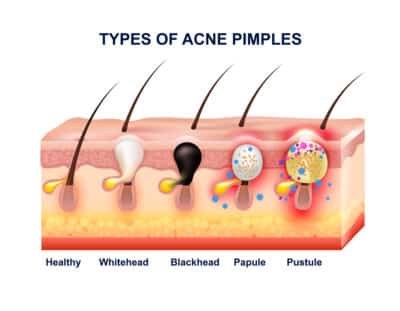
What are the types of acne?
Acne types are determined according to the intensity of the typical lesions described above. In this way, it is aimed to choose the most appropriate treatment method. The most common types of acne are as follows:
Comedonal acne: It is divided into two as open and closed comedones. It is frequently seen especially around the face and nose edge. It is most common in young people who are in adolescence and in people with excessively oily skin structure.
Inflammatory acne: Papules, pustules and lesser comedones are called. Nodulocystic acne: Comedones, papules and pustules and nodules are present.
There is a risk of scarring in nodulocystic acne type.
What are the types of acne scars?
Types of acne scars are divided into macules and scars:
Macules: Scars that are at the same level as the skin. They can only be observed as a redder or darker color. In particular, dark scars may remain in place of acne, where the tightening process takes place. These scars can be permanent if they do not last for a long time and if the appropriate treatment method is not applied.
Scars: Atrophic (pit) or hypertrophic (raised) are divided into two. The most common version is the pitted one.
How to treat acne?
All types of acne should be treated at any age. It reduces the risk of scarring after acne treatment. Acne is a skin condition that has a cure. However, it cannot be said that the acne treatment process takes a very short time. Response to treatment 2-3. starts a month. Patience is very important during acne treatment.
Mild acne is treated with antibiotic creams, solutions and gels applied to the upper layer of the skin. Oral antibiotic drug treatment is applied in moderately severe acne. These drugs are effective against the bacteria in the hair follicles, thereby reducing redness and inflammation. Birth control pills are extremely useful in acne caused by hormonal irregularity. Provides great improvement. Oral isotretinoin treatment is given in the treatment of acne in stubborn, scarring type or severe acne.
Among other treatment options, peeling treatments with the help of peeling, fruit acids and chemicals are some of the successful methods during acne treatment. Especially chemical peeling is a type of treatment that has been mentioned frequently recently. It is used to control the oil balance in skin with a lot of acne. Thus, the skin becomes cleaner and renewed. It is also very effective in the treatment of scars caused by persistent acne.
What are the acne treatment methods?
Acne treatment does not consist of only one treatment method. There is more than one treatment method. These methods are separated from each other according to the type and intensity of acne. These:
- Acne peeling treatment
- Treatment of acne with medication
- Laser acne treatment
- Treatment of acne with topical creams
- Medical skin care treatment
How to treat acne with topical creams?
It is a method generally used in the treatment of mild to moderate acne. It should be used for at least 8-12 weeks for the effect to be seen. Topical creams on the upper part of the skin destroy the microorganisms and bacteria that trigger acne formation on the skin, regulate sebum production and reduce acne formation.
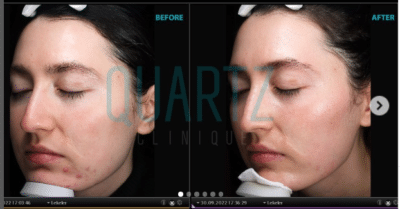 How to treat acne with medication?
How to treat acne with medication?
In cases where topical cream treatment does not respond, the patient is given oral medication. It is generally recommended for patients with moderate or severe acne.
How is laser acne treatment applied?
In the laser acne treatment method, it is ensured that the bacteria that cause acne formation are cleaned and the clogged fat cells in the lower layer of the skin are cleaned and the factors that increase the formation of acne are removed.
Why is acne treatment necessary?
Acne treatment is an extremely necessary application in order to prevent the formation of scars on the skin.
It prevents cysts and nodules that are in the healing period from leaving marks on your skin. It is very difficult to remove the scars after acne and bring the skin to a smooth level. Another importance of acne treatment is to reduce the time spent with acne. At the same time, with acne treatment, psychological problems caused by too many acne and scars on the skin are eliminated.
Is acne treatment permanent?
Acne treatment is extremely successful in controlling acne, but acne does not completely resolve with medical methods. After the treatment, if the patient takes good care of his skin and removes the factors that cause acne, the risk of recurrence of the disease is considerably reduced. In addition, your dermatologist may plan a follow-up treatment to prevent recurrence of acne. One of the most frequently asked questions in acne treatment is whether acne will occur again after treatment. There is no guarantee for this situation. Although it depends on the skin structure of the person, if the person has oily skin, recurrence can be observed. However, this problem can be easily eliminated with the use of the right product that prevents skin lubrication. With acne treatment, new acne formation is controlled and scars are prevented.
Is acne treatment painful?
Acne treatment is not a painful procedure. No pain or side effects are observed.
Does acne treatment work immediately?
The immediate effect of acne treatment varies from person to person. Depending on the type of acne seen in the person, the skin structure of the person and the underlying cause of acne formation, the duration of acne treatment also differs.
Is it okay to use cosmetic products during acne treatment?
During and after acne treatment, you must use the right products with the advice and control of your dermatologist. Soaps and lotions that clean the skin, products that refresh the moisture balance of the skin and other care products are some of these products.
How to prevent acne formation?
- Be sure to consult your dermatologist for treatment.
- Extreme fatigue and intense stressful life increase oil production in some hormones. This invites acne breakouts. Staying away from fatigue and stress as much as possible prevents acne formation.
- During sleep, the skin renews itself. Therefore, a quality sleep is important for your skin health.
- As in the prevention of most diseases, a healthy diet program and regular exercise accelerate the blood circulation in the skin and ensure that more oxygen is transferred to the cells.
- Squeezing acne increases the risk of scarring. Removing acne is not a solution.
- Washing hands frequently is important for facial health. Touching the face frequently with dirty hands increases the amount of bacteria and acne formation increases accordingly.
- It is necessary to wash the face twice a day with the cleansing gel used by the dermatologist’s recommendation. Towels should be changed frequently.
- Excessive sun exposure can also increase acne formation. After intense sun exposure, the skin thickens to protect itself and becomes more tan. As a result of thickening of the skin, the pores are clogged and acne increase can be observed.
What are acne treatment prices?
Acne treatment is determined according to the needs of the patient. That’s why acne treatment pricing varies. It is not legal for centers approved by the Ministry of Health to indicate prices on their websites. You can contact our clinic at +902122414624 for more detailed information about acne treatment prices and for all your other questions.

